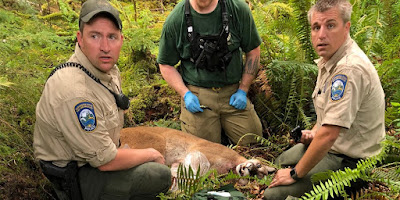A cruise ship vacation could be renamed a "meat vacation."
What resources are used on a cruise ship? Fuel readily comes to mind, since these huge ships and their cargo need to be moved across oceans (interestingly, propulsion and maneuvering use only about 60% of the fuel). But those 3000+ guests and the 1200+ staff need to be fed as well. On the Celebrity Solstice, there are numerous dining areas, with 167 chefs and 71 cleaners working every day (and night) to provide the guests with enough food to maintain the gluttonous army that descends, every week or two, onto the ship.
Executive Chef Muthukkumar Balakrishnan distributed a flier outlining what they serve on the "average 7 day cruise." I assume these figures are for both guests and crew.
 |
| Flesh abounds on a cruise ship, with no effort to tell consumers where it came from, how it was raised, or whether its production and processing abide by any conventional standard. |
Beef: Clearly, steers are the animals of choice in the meals here. The ship will use 14,542 pounds of beef on that average 7 day cruise. Currently, I'm on a 19 day cruise, so the amount used will be more than double that figure. You get about 490 pounds of boneless, trimmed meat from one 1200 pound steer. So that 7 day trip translates into almost 30 steers consumed (60+ for this cruise). I suspect consumption wouldn't change if the guests watched 30 steers herded up the gangway, but it would be honest. In addition, according to one industry estimate, that 14,542 pounds of beef took over 154,000 pounds of feed in the feedlot, and over 116,000 gallons of water to produce. Oh, and the steer produce manure that can flow into our streams, rivers, and oceans, and the corn producers apply excess nitrogen to their fields to maximize production. That excess nitrogen flows into the ocean as well.
Do you think those guests worry about those 30 steers, how they lived and died? Do you think they worry about the dead zone in the Gulf of Mexico (in 2017, about the size of New Jersey). Do they consider the relationship between eating beef and climate change?
 |
| 2015 "dead zone" in the Gulf of Mexico, caused by nutrient runoff. |
No, cruise ships give guests what they want... lots of food (especially beef) and alcohol. Damn the consequences, full speed ahead! There is a 2020 sustainability goal for parent company Royal Caribbean to "... conduct an analysis of key food commodity categories (meat, dairy, oils, vegetables, fresh fruits, sugar, grains, tea and coffee) to identify and prioritize commodities with the highest environmental impact by the end of 2016. Following the prioritization, RCL and WWF will work to develop strategies to improve sustainable sourcing practices by 2020." Beef should rank way up there... I'm curious what is in the works for a "sustainable sourcing practice."
Other meats: For that average 7 day cruise, people will consume another 2560 pounds of pork, 1650 pounds of "sausage" (more pork?), 2965 pounds of turkey, 2925 pounds of lamb, 2564 pounds of abused calves (veal), and 7242 pounds of chicken (that's from thousands of chickens). For seafood, people will consume 12652 pounds of fish and 1600 pounds of lobster. I'd like to know about shrimp consumption. I've discussed the lack of information about sustainable fish sourcing elsewhere.
Eggs and dairy: For that average 7 day cruise, people will consume 12000 eggs, drink 20219 gallons of milk, eat 650 gallons of ice cream, and use 203 gallons of cream.
Alcohol: For that average 7 day cruise, people will drink 460 bottles of champagne, 550 bottles of vodka, 316 bottles of rum, 250 bottles of gin, 216 bottles of whiskey, 56 bottles of sherry, and 12450 bottles of wine. Add to this 35000 liters of beer... I think this equates to 9865 bottles or cans (no beer on tap). The beer count is raised markedly when the trip is based in Australia. There appears to be an aggressive program to recycle glass bottles and aluminum cans.
Fruits and vegetables: For that average 7 day cruise, people will consume 12450 pounds of potatoes, 32652 pounds of fresh fruit, 8000 pounds of white rice, 48659 pounds of fresh vegetables, 4250 pounds of coffee, and 19000 tea bags.
 |
| A screen shot from a presentation by the ship's environmental officer. |
Of course, all the food isn't eaten, so the ship has to manage the food waste as well. If possible, excess food goes to the crew's galley, but after 4 hours it is discarded. Eventually, excess or waste food is pulped, then discharged overboard as per policy.









Comments
Post a Comment